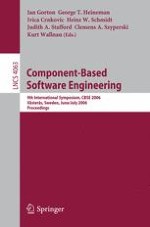On behalf of the Organizing Committee I am pleased to present the proceedings of the 2006 Symposium on Component-Based Software Engineering (CBSE). CBSE is concerned with the development of software-intensive systems from reusable parts (components), the development of reusable parts, and system maintenance and improvement by means of component replacement and customization. CBSE 2006 was the ninth in a series of events that promote a science and technology foundation for achieving predictable quality in software systems through the use of software component technology and its associated software engineering practices. We were fortunate to have a dedicated Program Committee comprising 27 internationally recognized researchers and industrial practitioners. We received 77 submissions and each paper was reviewed by at least three Program Committee members (four for papers with an author on the Program Committee). The entire reviewing process was supported by Microsoft’s CMT technology. In total, 22 submissions were accepted as full papers and 9 submissions were accepted as short papers. This was the first time CBSE was not held as a co-located event at ICSE. Hence special thanks are due to Ivica Crnkovic for hosting the event. We also wish to thank the ACM Special Interest Group on Software Engineering (SIGSOFT) for their sponsorship of CBSE 2005. The proceedings you now hold were published by Springer and we are grateful for their support. Finally, we must thank the many authors who contributed the high-quality papers contained within these proceedings.
